Abstract
This research introduces a compact, self-isolated, 12 × 12 multiple-input multiple-output (MIMO) antenna array designed for 5G mobile applications, operating within the 3.5 GHz band (3.42–3.62 GHz). The array consists of two distinct sets of six antenna elements—inverted U-shaped and T-shaped structures, each incorporating two circular and I-shaped strips—arranged symmetrically within the smartphone chassis. Each antenna element measures 15 × 5 mm2 (0.17λo × 0.06λo), where λo represents the free-space wavelength at 3.5 GHz. These elements function simultaneously as radiators and isolators, achieving high isolation levels. Additionally, the 12-MIMO antenna elements, designed to be self-isolated, are fabricated on both sides of two compact FR-4 substrates, positioned orthogonally to the ground substrate. This perpendicular configuration augments the self-isolating mechanism. The scattering parameters (s-parameter) findings demonstrate significant decoupling measuring under −19 dB across neighboring 12-MIMO elements. Moreover, the MIMO performance metrics, including channel capacity loss (CCL), total active reflection coefficient (TARC), diversity gain (DG), and the envelope correlation coefficient (ECC), are presented to be below 0.08 bits/s/Hz, −10 dB, 9.97 dB, and 0.006 consecutively. The significant isolation and performance metrics results notably indicate that the presented 12-MIMO antenna system is well-suited for 5G communication systems.
1. Introduction
The existing 5G infrastructure provides a robust solution to the shortage of data rates and the significant upsurge in the number of gadgets in wireless communications. It offers speeds that are ten times higher, operating within a frequency range of about 1–10 GHz, compared to less than 100 MHz for 3G and 4G wireless networks. The 5G technology spans a wide range of spectrum bands, ranging from 700 MHz at the lower end to higher frequencies ranges reaching up to 90 GHz [1,2]. Specifically, the frequency range below 6 GHz, particularly the frequency band of 3.4 to 3.6 GHz range, is a mid-frequency band for 5G advanced wireless communication that supports a spectrum width range of approximately 100–500 MHz [3,4]. The main objective of the band at 3.5 GHz is to enable high-speed communication and establish a highly efficient system for data transmission with a fast data transfer rate, catering to the tremendous upsurge in users [5,6]. Consequently, the spectrum under 6 GHz 5G frequency is utilized for wireless mobile communications by deploying MIMO antennas at both the transmitting and receiving terminals [7,8].
The MIMO technology significantly contributes to improving channel capacity to address the substantial growth in numbers of mobile devices and the corresponding low transmission speed [9,10]. On the other side, with the increase in the number of antennas, the associated issues of high mutual coupling escalate, which can negatively impact the MIMO antennas’ performance and subsequently reduce their efficiency, particularly in very compact and adjacent MIMO configurations [11,12]. Furthermore, the trend toward compact and lightweight modern smartphones amplifies the demand for compact adjacent antenna elements. Consequently, developing a closely spaced and compact MIMO antenna system for 5G smartphone applications while ensuring high isolation levels presents a significant technical challenge. Various decoupling methods have been introduced to improve decoupling in MIMO antennas operating within the band at 3.5 GHz, including strategies like optimizing antenna placement and adjusting their orientation [13,14,15,16,17,18], Neutralization lines [19,20,21,22], decoupling networks, [23,24,25,26,27], slot elements [28,29,30,31], metamaterials [32,33,34,35], and self-isolation techniques [36,37,38]. For instance, the use of metamaterials, including slotted-complementary, split-ring resonators, has shown significant potential in reducing mutual coupling between antennas [39]. Similarly, single-negative magnetic metamaterials have been employed to mitigate electromagnetic coupling in monopole antennas for MIMO applications [40]. There are digital techniques that can take into account the mutual coupling in the transmission that includes linearization through beam-dependent compensation of mutual nonlinear coupling [41]. In this study, the 5G MIMO antenna system demonstrates a notable ability to mitigate multipath fading effectively while delivering enhanced channel capacity [42,43]. Nevertheless, the MIMO antenna elements proposed in the study continue to exhibit substantial separation distances between adjacent antennas, which leads to increased MIMO dimensions. Additionally, the isolation levels reported in these studies are merely more than 10 dB, which remains relatively low. Moreover, the research focused on utilizing MIMO configurations of only four or eight antennas at the band 3.5 GHz spectrum.
In this work, a compact, self-isolated, twelve-element MIMO antenna system is designed utilizing an orthogonal configuration, where the antennas are positioned orthogonally on the two lateral edges of compact substrate material. These antennas function simultaneously as both isolating and transmission elements. Additionally, the MIMO antennas are designed to be miniaturized and closely aligned, enabling the deployment of higher MIMO orders. The performance of the MIMO antenna system is thoroughly assessed using key metrics, including the envelope correlation coefficient (ECC), channel capacity loss (CCL), total active reflection coefficient (TARC), mean effective gain (MEG), and diversity gain (DG). The proposed compact and closely spaced 12-MIMO antenna system achieves both impedance bandwidths of −6 dB and −10 dB within the frequency band at 3.5 GHz.
2. Antenna System Design
In this work, a self-isolating antenna component is designed to fulfill the requirements of 5G wireless applications within the sub-6 GHz frequency range. The proposed structure integrates an inverted U-shaped element along with a T-shaped element, as illustrated in Figure 1. To enhance performance, two small strips are incorporated at each side of the T-shaped component. Additionally, the coupling element is shifted to the left until it makes contact with the circular structure. This design process involves a parametric sweep, where the horizontal position of the T-shaped element and the circle is systematically varied to analyze its impact on the system’s behavior. Through this parametric sweep, the transition from a coupled regime to a direct feed-through regime can be studied, enabling the identification of optimal design parameters for the intended application. Additionally, a pair of I-shaped stubs are integrated on each side of the inverted U-shaped element, to further refine the antenna’s performance. Three crossed I-shaped elements are strategically placed at the center of the design to improve impedance matching and isolation. The antenna achieves excellent impedance matching, with S11 < −10 dB and a Voltage Standing Wave Ratio (VSWR) < 2, as well as S11 < −6 dB and VSWR below 3 over the 3.5 GHz spectrum. A FR-4 substrate has been utilized to fabricate the 12 antenna elements, featuring compacted dimensions of 15 × 5 × 1.6 mm3, ensuring compatibility for integration into contemporary smartphone designs. In Figure 1, the height and length of the antenna are represented by L and H1, respectively, while the height and the length of the T element are denoted by M and N consecutively. Additionally, H2 and H3 indicate the length and height of the vertical and crossed small stubs, respectively. The parameters S, S1, S2, S3, and S4 describe the width, size, and displacements of the Circular Ring Resonator (CRR), as indicated in Figure 1. The structural pacifications of the self-isolated proposed antenna are outlined in Table 1.

Figure 1.
The structural configuration of an individual antenna within the 12-MIMO antenna array.

Table 1.
The parameters of the proposed antenna design.
The reflection coefficient S11 of the proposed antenna element is illustrated in Figure 2 depicting a resonant frequency of 3.5 GHz and readings falling lower than −10 dB. This coefficient can be fine-tuned by modifying the parameters M, L2, N, and H2.
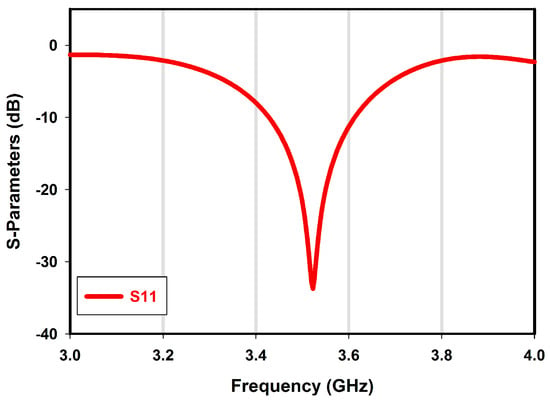
Figure 2.
The reflection coefficient S11 of the single antenna.
Figure 3 illustrates the design evolution to achieve resonance at 3.5 GHz for 5G smartphone applications. Initially, the inverted U-shaped element resonates above 6.2 GHz, as depicted in Figure 3a,b. In Figure 3c, the addition of vertical stubs lowers the resonant frequency to 5.8 GHz while improving the reflection coefficient, as depicted in Figure 3d. This demonstrates that reducing the frequency requires lengthening the current path by incorporating stubs. However, as seen in Figure 3d, the reflection coefficient results still indicate a frequency higher than the desired 3.5 GHz band.

Figure 3.
Design evolution and corresponding reflection coefficient results: (a) inverted U-shaped element; (b) reflection coefficient above 4 GHz; (c) U-shaped element with stubs; (d) reflection coefficient above 4 GHz; (e) addition of circular rings; (f) resulting reflection coefficient; (g) inclusion of two horizontal stubs; and (h) reflection coefficient of the final design.
To address this, double circular rings were introduced near the coupled-fed, T-shaped element, further increasing the current path and shifting the resonant frequency to the 3.5 GHz frequency range, as demonstrated in Figure 3e. The addition of the circular rings successfully extended the current path, resulting in a resonant frequency of 3.59 GHz, as evidenced in Figure 3f. This design process highlights a fundamental tradeoff: miniaturizing the antenna size typically reduces the current path, which in turn increases the resonant frequency. To counteract this, adding stubs to lengthen the current path becomes essential for achieving lower resonant frequencies.
To further optimize the design, two stubs were added horizontally on both sides of the T-shaped feeding element, as illustrated in Figure 3g. These stubs help shift the resonant frequency and significantly improve the S-parameter results by creating an additional current path, thereby enhancing the S11 at 3.5 GHz, as illustrated in Figure 3h.
The spatial distribution of surface currents across the proposed antenna is presented in Figure 4 when operating at 3.5 GHz band, providing insight into its operational behavior. As depicted in the figure, the current distribution is asymmetrically concentrated on either sides of the inverted U-shaped component, as a result of the asymmetrical placement of the circular rings. The T-shaped element at the center plays a crucial role in ensuring a good distribution of current across the designed antenna element. Additionally, the I elements exhibit a significant concentration of current near the inverted U-shaped edges. The horizontal I-formed components at the center also show a notable current buildup, which contributes to improved impedance optimization. The observed current distribution across the antenna element highlights its capability to effectively regulate the resonant frequency, ensuring compliance with the 5G requirements for mobile applications.
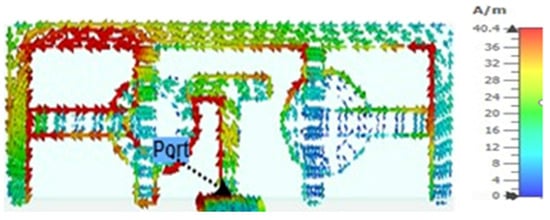
Figure 4.
The flow of current of the designed antenna across the surface at 3.5 GHz.
A parametric study was conducted to identify the optimal edge-to-edge distance between two MIMO antenna elements. Figure 5a,b shows the s-parameters for various distances (d), ranging from 4 mm to 8 mm representing the reflection and transmission coefficients (S11 and S12) consecutively. The isolation between the two MIMO antenna elements is most effective at d = 8 mm, with a value of less than −24 dB, outperforming the isolation results at other distances, as shown in Figure 5b. Additionally, at d = 8 mm, the reflection coefficients (S11 and S22) demonstrate excellent impedance matching, resonating precisely at 3.5 GHz as displayed in Figure 5a. In contrast, at other distances, the reflection coefficients exhibit impedance mismatching, with S11 and S22 resonating at different frequencies. Thus, an 8 mm end-to-end spacing between the two antennas is identified as the optimal configuration, ensuring both efficient transmission coefficients and effective impedance matching for reflection coefficients. Additionally, this close spacing facilitates the integration of 12-MIMO antennas with high self-isolation while preserving a compact single-antenna size of 15 × 5 mm2 and total MIMO antenna dimensions of 133.5 × 5 mm2.
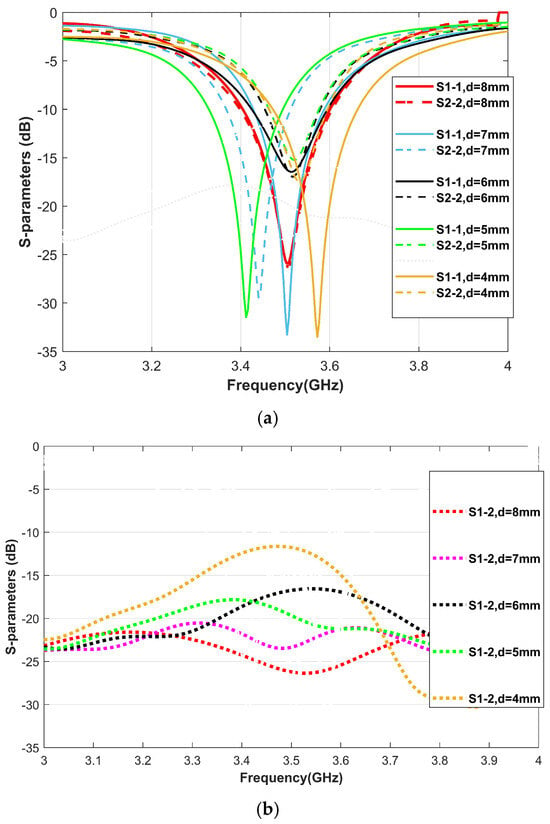
Figure 5.
The s-parameters with varying distances; (a) reflection coefficients; (b) transmission coefficients.
The layout of the designed two MIMO antennas is presented in Figure 6. The end-to-end separation d was fixed at 0.1λ0, approximately 8 mm, as this spacing ensures substantial isolation and enables the highest MIMO order required for building the 12-MIMO antenna system. The antennas were vertically etched on miniaturized substrate measuring 133.5 × 5 × 1.6 mm3, arranged orthogonally to the main system substrate.

Figure 6.
The proposed two-MIMO antennas for 5G smartphone applications.
The simulated scattering parameters of the two antenna elements are presented in Figure 7, spaced at a distance of d = 0.1λ0. The indicated return loss values (S11 and S22) at 3.5 GHz resonance within the −10 dB bandwidth, with measurements consistently under −20 dB, demonstrating excellent impedance matching. Additionally, the transmission coefficient in Figure 5 indicates substantial decoupling, achieving less than −25 dB within the 3.5 GHz band, in spite of the minimal spacing and the miniaturized dimensions of the antenna.
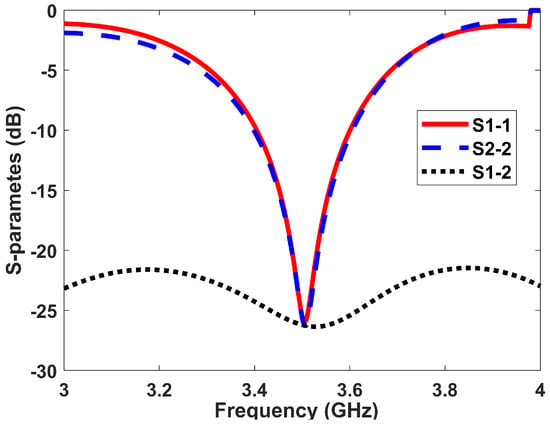
Figure 7.
The scattering parameters of the 2-MIMO antenna elements.
To further analyze the performance of the 2-MIMO antennas resonating at 3.5 GHz, Figure 8 demonstrates the current distribution across the surface of the 2-MIMO antennas when antenna 1 is excited. As clearly observed, the majority of the current is primarily concentrated within the area of the excited antenna, with minimal current reaching the neighboring antenna. This behavior results in high self-isolation between the elements. Consequently, the designed antenna functions effectively as both an isolating and radiating element, achieving significant decoupling performance.

Figure 8.
The flow of current across the 2 antennas at 3.5 GHz.
The side and perspective views of the proposed 6 + 6 MIMO antenna system are presented in Figure 9a,b, designed for 5G smartphone applications operating at 3.5 GHz. The MIMO antenna system is constructed using FR-4 material with a thickness of 1.6 mm, featuring overall dimensions of 150 × 75 × 1.6 mm3. This design ensures easier and more seamless integration into a 5.49-inch smartphone. The system incorporates a total of 12-MIMO antenna elements, which are fabricated on the two sides of small substrate boards, and each substrate measures 133.5 × 5 × 1.6 mm3. A sufficient spacing of 22.5 mm is maintained at the periphery of the substrate of the system to accommodate additional communication standards, including 2G, 3G, and 4G antenna elements. The miniaturized design of each individual antenna element, with dimensions of 15 × 5 mm2, along with an end-to-end separation distance of d = 0.1λ, results in a compact and highly isolated 12-MIMO antenna array.

Figure 9.
The general view of the 12-MIMO antenna system: (a) perspective view; (b) side view.
The flow of current of the presented MIMO antenna array is depicted in Figure 10a–f, corresponding to the excitation of antennas 1 through 6, respectively. To maintain conciseness and consider the vertical symmetry of the MIMO antenna system, the analysis was limited to six antenna components. The flow of current remains concentrated around the activated antenna, with minimal coupling to neighboring antennas in spite of their close spacing, as demonstrated in Figure 8. This behavior highlights the excellent isolation characteristics of the proposed antenna elements, effectively reducing mutual coupling within the MIMO system.
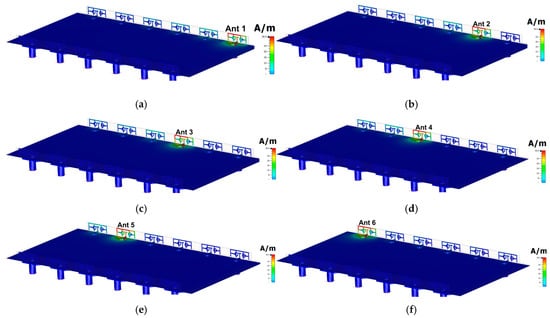
Figure 10.
Surface current of the 12-MIMO antenna elements when exciting: (a) Ant 1; (b) Ant 2; (c) Ant 3; (d) Ant 4; (e) Ant 5; and (f) Ant 6.
3. MIMO System Prototype
The prototype of the 12-MIMO antenna system has been fabricated, as illustrated in Figure 11a–c. To measure the s-parameters and radiation patterns, 50 Ω SMA, two-hole panel, flange jack connectors were soldered onto the feeding strips of the antenna elements. During testing, all antenna elements were connected to 50 Ω loads while the antenna under test was excited to obtain the s-parameter and radiation pattern measurements. Some discrepancies in the results are expected due to various factors, including human error, limitations in the measurement setup (such as cable losses and calibration errors), impedance mismatches between the measurement equipment and antenna ports, and positioning inaccuracies. These inaccuracies could arise from misalignment of the antenna under test (AUT) within the anechoic chamber or near-field measurement environment. Besides, fabrication tolerances also might have impact such as substrate imperfections, etching errors, and imperfect soldering that might introduce additional parasitic inductance and capacitance, affecting the antenna’s performance.
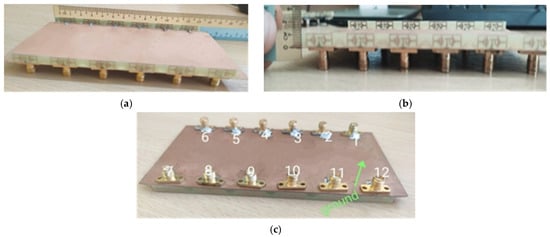
Figure 11.
The fabrication and the setup for the 12-MIMO antenna system: (a) top view; (b) side view; and (c) back view.
Another key technique employed in this work is the orthogonal mode, which enhances isolation between antenna elements by generating two regions with opposing magnetic fields. In this method, the 12-MIMO antennas are positioned on compact, edge-defined substrates, oriented perpendicular to the system ground. This unique self-isolation strategy, enabled by the orthogonal mode, significantly improves the isolation performance of MIMO antenna systems for 5G mobile applications.
4. Results and Discussion
Figure 12a–c present the simulated and measured s-parameters of the 12-MIMO antenna system, including reflection and transmission coefficients. To maintain clarity and conciseness, not all antenna elements are shown, as the system is vertically symmetric. The simulated reflection coefficients in Figure 12a–c demonstrate that all antenna elements achieve proper impedance matching, resonating at 3.5 GHz with an impedance bandwidth of approximately 200 MHz, covering 3.4 GHz to 3.6 GHz, which is suitable for 5G sub-6 GHz mobile applications. Additionally, the simulated transmission coefficients in Figure 12a–c indicate strong isolation between all antenna elements, with adjacent elements maintaining isolation levels below −19 dB. The measured results further confirm that isolation remains below −18 dB across all antenna ports. A good agreement between simulated and measured results is observed. A slight shift in operating frequency is observed due to the fabrication imperfections and the reflections from the SMA connectors.
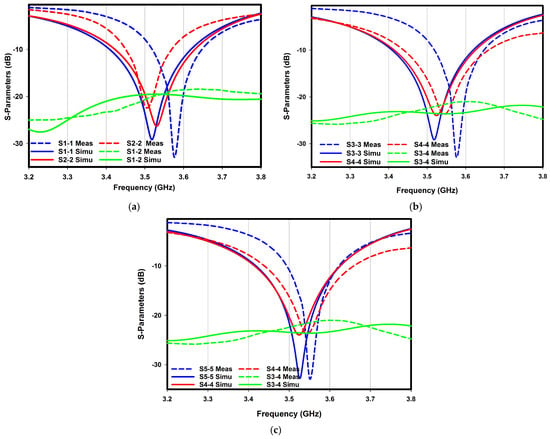
Figure 12.
S-parameter measurements and simulations: (a) S1-1, S2-2, and S1-2; (b) S3-3, S4-4, and S3-4; and (c) S4-4, S3-4, and S5-5.
Figure 13a–h present the radiation patterns obtained from both simulation and measurement of the 12-MIMO antenna system, illustrating co-polar (phi) and cross-polar (theta) components in the x–y plane. The radiation patterns were measured for four antenna ports, while the remaining antennas were terminated with a 50 Ω matching load. Due to the symmetrical arrangement of the MIMO antennas along the side edges, the radiation patterns of the other elements were not included for brevity. Figure 13a,c,e,g depict the measured and simulated co-polar (E-phi) radiation patterns, showing maximum radiation for the horizontal antennas at ports 1, 2, 3, and 4, which reside at 210°. Meanwhile, Figure 13b,d,f,h illustrate the cross-polar (theta) radiation patterns, where the peak radiation occurs at 90° and 150°. Overall, the measured and simulated results exhibit high consistency, with minor discrepancies arising from manufacturing defects and cable attenuation.
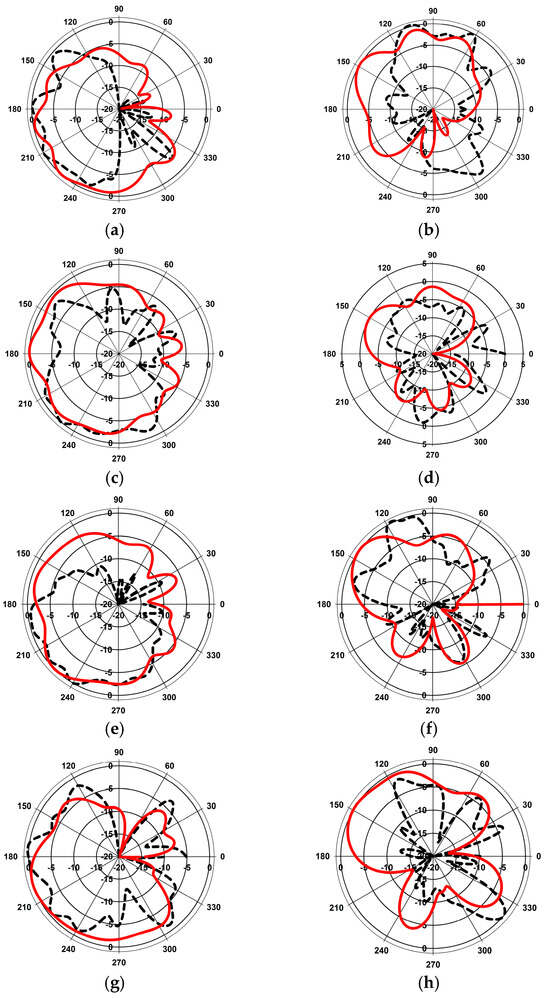
Figure 13.
The optimized-measured and simulated 2D radiation patterns of the 12-MIMO antenna elements at 3.5 GHz: (a) Ant1 Phi; (b) Ant 1 theta; (c) Ant 2 Phi; (d) Ant 2 theta; (e) Ant 3 Phi; (f) Ant 3 theta; (g) Ant 4 Phi; and (h) Ant 4 theta.
5. MIMO Antenna Performance Evaluation
The presence of multiple transmission paths in MIMO systems plays a crucial role in significantly enhancing channel capacity. Ideally, adding more antennas leads to improved MIMO channel performance. However, excessive coupling between MIMO antenna elements can negatively impact system efficiency, potentially reducing channel capacity as the number of antennas increases. To address this, evaluating the diversity performance of the MIMO system is essential for understanding coupling effects and demonstrating how the 12-MIMO antenna system contributes to improving channel capacity. MIMO performance parameters such as mean effective gain (MEG), ECC, DG, CCL, and TARC are computed using equations as shown below. Moreover, the specific absorption rate (SAR) is analyzed using CST simulation to evaluate the impact of the MIMO antenna system radiation on the user.
The ECC is a remarkable parameter to determine the mutual coupling effect and the amount of correlation between two antenna elements. It is computed based on the s-parameters using Equation (1).
In practical MIMO antenna applications, the maximum permissible ECC value is ≤0.5 [23]. Figure 14a,b illustrate the ECC values for the 12-MIMO antenna elements. To maintain brevity, ECC calculations were not performed for all elements, considering the vertical symmetry of the MIMO structure. Figure 14a illustrates the ECC for antenna 1 in relation to the remaining 11-MIMO antenna elements. The correlation between antennas 1 and 2 remains extremely low, measuring less than 0.0005 at 3.5 GHz, while the correlations with other antennas are below 0.002. Similarly, Figure 14b presents the ECC values for antennas 8, 9, and 10 with respect to the rest of the antenna elements, showing a low correlation of less than 0.0019 across the entire 12-MIMO system. Figure 13 highlights the measured ECC results for closely positioned antennas, where the ECC of antennas resonating at 3.5 GHz remains below 0.06, as shown in Figure 15. The overall ECC performance aligns well with both the simulated and measured results. From Figure 14a,b and Figure 15, it is evident that the correlation in the 12-MIMO antenna system is significantly lower than the maximum acceptable threshold, confirming the system’s excellent isolation performance.
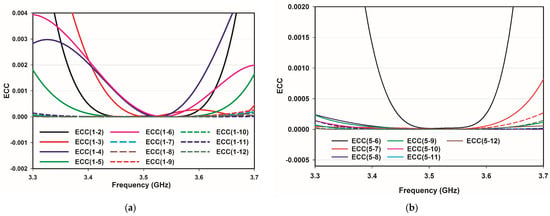
Figure 14.
ECC of the 12-MIMO antenna system: (a) ECC1-12; (b) ECC8-12, ECC9-12,, and ECC10-12.
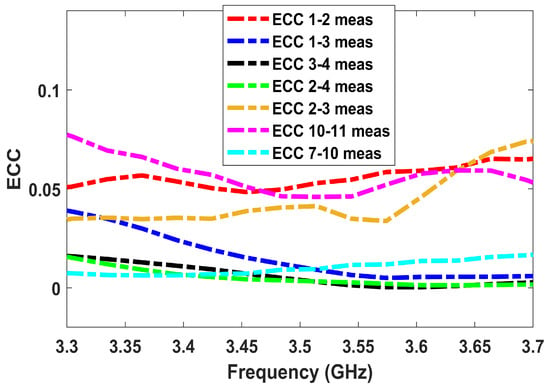
Figure 15.
The measured ECC of the 12-MIMO antenna elements.
Moreover, the MEG is a vital parameter for evaluating MIMO antenna systems, as it quantifies power imbalance between antennas in fading environments. The acceptable value for MEG ≤3 dB, as depicted in Equation (2). MEG for MIMO antenna elements represents the ratio of the average received power to the incident power and is determined using s-parameters, as expressed in Equation (3) [44]. Figure 16a,b illustrate the calculated MEG for the 12-MIMO antenna system. Figure 16a presents the MEG values for antennas 1–4 and vice versa at 3.5 GHz, showing that each antenna maintains an MEG below 3 dB, approximately −6 dB, which meets the acceptable MEG criteria. However, to compute the MEG between two MIMO antennas, the power level k must be less than 3 dB for practical applications, while, in ideal situations, it must be 0 dB, as indicated in Equations (4) and (5).
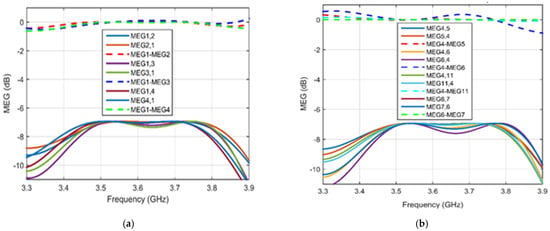
Figure 16.
MEG of the 12-MIMO antenna elements: (a) MEG 1-2, 1-3, and 1-4; (b) MEG 4-5, 4-6, 4-11, and 6-7.
Another key evaluation metric is the power ratio, which should ideally be close to unity for optimal performance, as defined in Equation (5). Figure 16a illustrates that MEG1,2 is derived from the difference between MEG1 and MEG2, resulting in a value of approximately 0.0131 dB, which meets the MEG’s acceptable value. The ratio MEGᵢ/MEGⱼ exceeds 0.988, which is very close to the ideal unity value of 1 dB, thereby fulfilling the equality criterion for the two antenna elements, as shown in Table 2. Similarly, Figure 16a presents the MEG values for antenna pairs 1,3 and 1,4. Meanwhile, Figure 16b displays the MEG values between antenna 4 and antennas 5–7, as well as between antennas 6 and 7, all of which remain below 3 dB.

Table 2.
MEG of the 12-MIMO antenna elements.
Figure 17 presents the measured MEG results for the 12-MIMO antenna elements, showing values below −6 dB. These measured results align well with the simulated results, confirming that the MEG values remain below the maximum permissible limit of 3 dB and approach an ideal power ratio close to unity. A summary of the MEG values across the 12-MIMO antenna elements is provided in Table 2, which also details the power levels and power ratio between coupled antenna elements. Thus, both the measured and simulated MEG results validate that the 12-MIMO antenna system meets the required MEG power level of less than 3 dB, with a power ratio of approximately unity.
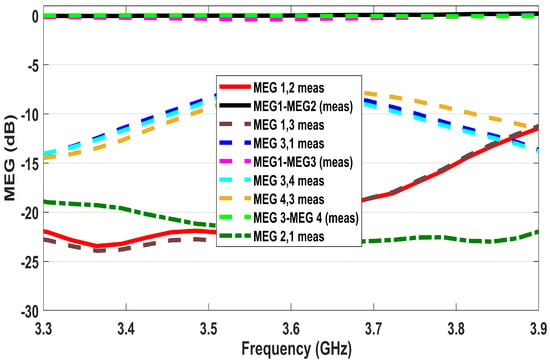
Figure 17.
The measured MEG of the 12-MIMO antenna elements: MEG 1-2, 1-3, 3-4, and 2-1.
Diversity gain (DG) is also a significant parameter to evaluate the MIMO diversity using Equation (6)
Figure 18a,b illustrate the DG values for the 12-MIMO antenna system. Figure 18a presents the DG for antenna 1 in relation to the other 12-MIMO antenna elements at 3.5 GHz, recording approximately 9.99 dB. Meanwhile, Figure 18b displays the DG values for antennas 4–12, demonstrating outstanding performance with values reaching 9.997 dB across the correlated elements. Figure 19 further showcases the measured DG values for the 12-MIMO antenna elements, all exceeding 9.957 dB—closely approaching the ideal DG value of 10 dB at the 3.5 GHz band. The measured results align well with the simulations, confirming excellent diversity performance.
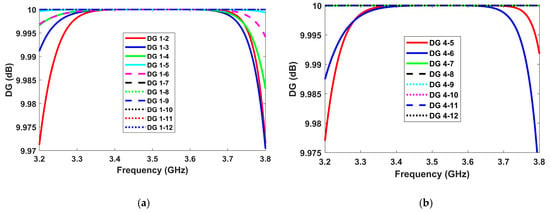
Figure 18.
The DG results of the 12-MIMO antenna system: (a) Ants 1-12; (b) Ants 4-12.
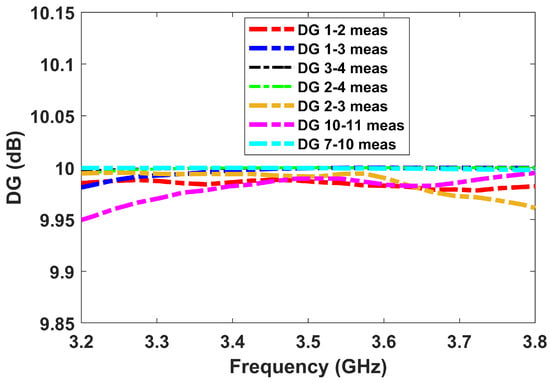
Figure 19.
The DG-measured results of the 12-MIMO antenna elements.
Thus, as observed in Figure 18 and Figure 19, the DG values for 12-MIMO antenna elements are consistently close to the ideal DG value of 10 dB [45,46]. This confirms that the DG results exhibit outstanding diversity performance, reinforcing the 12-MIMO antenna system as a highly suitable option for 5G mobile applications.
TARC is a key performance metric used to assess the efficiency of a MIMO system, as it provides insights into mutual coupling and the system’s return loss. The TARC values have been derived using Equation (7), where the optimal and maximum permissible value for a MIMO antenna system is 0 dB or lower [47,48]. As illustrated in Figure 20a, the TARC values for antenna 1, when correlated with antennas 2–5 and 11–12, remain below −20 dB at 3.5 GHz, demonstrating excellent isolation and performance.
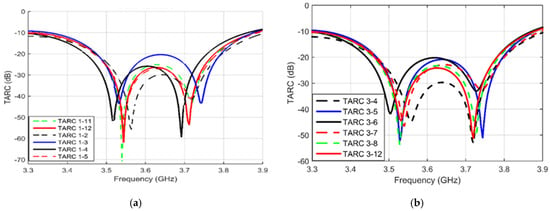
Figure 20.
The TARC results of the 12-MIMO antenna system: (a) Ants (1,2-5) and (1,11-12); (b) Ants (3,4-8) and (3,12).
Figure 20b displays the TARC results of antenna 3 correlated with antenna elements 4-8 and 12, where it is less than −15 dB. Figure 21 shows the measured TARC results of the correlated antennas 1-2, 2-14, 3-4, and 10-11, indicating values less than −13 dB at 3.5 GHz. It is also noted that the measured TARC values of antennas 1-2 and 10-11 resonate at 4.1 GHz due to the frequency shift of the measured s-parameters of these antennas because of the fabrication imperfections. As a result, Figure 20 and Figure 21 present a significant TARC of less than −13 dB, which meets the TARC acceptable value. Moreover, the consistency in the TARC-measured and simulated results shows that the 12-MIMO antenna system exhibits excellent diversity based on its reflection coefficient. Furthermore, the notable TARC results demonstrate the effectiveness of the presented 12-MIMO antenna system, which incorporates a robust self-isolation mechanism for 5G smartphone applications.
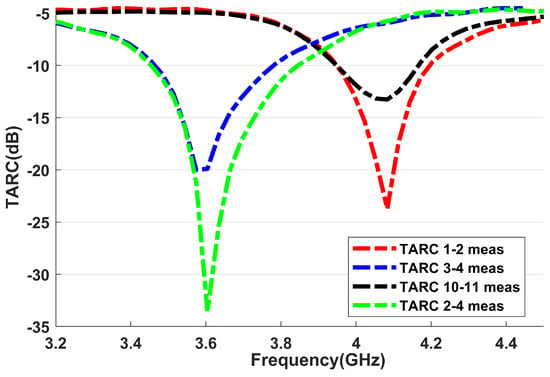
Figure 21.
The TARC-measured results of the 12-MIMO antenna elements.
When the order of antennas in a MIMO system surges, the channel capacity experiences a substantial enhancement. However, this also leads to higher losses due to the correlation factor among MIMO antennas. Consequently, CCL plays a crucial role in evaluating the performance of the proposed MIMO system, as it quantifies the channel capacity losses resulting from correlation effects. The CCL is calculated using Equation (8).
For MIMO antennas, the acceptable CCL threshold should remain below 0.4 bit/s/Hz across the entire bandwidth [23,49,50,51]. Figure 22a illustrates the CCL between antenna 1 and antennas 2-7 and 12, showing values lower than 0.0391 bit/s/Hz at 3.5 GHz. Similarly, Figure 22b presents the CCL losses between antenna 4 and antenna elements 5-11 and 6-7, all remaining below 0.4 bit/s/Hz.
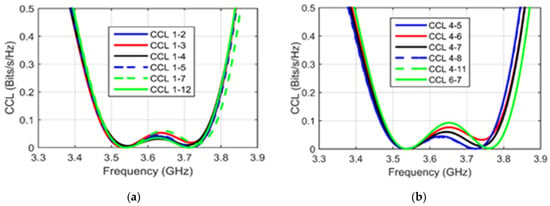
Figure 22.
The CCL results of the 12-MIMO antenna system: (a) Ants 1-12, (b) Ants 4-11, and Ants 6-7.
Figure 23 shows that the measured CCL results for antennas 1-2 and 10-11 remain below 0.08 bits/s/Hz at 3.5 GHz. However, due to fabrication imperfections causing a deviation in the resonant frequency of the s-parameters, the CCL values have shifted to 4.1 GHz, where they remain under 0.12 bits/s/Hz. The measured and simulated CCL results agree, depicting low losses. It can be seen from the measured and simulated results in Figure 22 and Figure 23 that the CCL losses for the 12-MIMO antenna elements are lower than the practical standard CCL value of 0.4 bits/s/Hz. Consequently, the 12-MIMO antenna system demonstrates an effective diversity performance with minimal losses, ensuring high throughput. Table 3 provides a summary of the CCL losses at 3.5 GHz for the correlated 12-MIMO antenna elements.
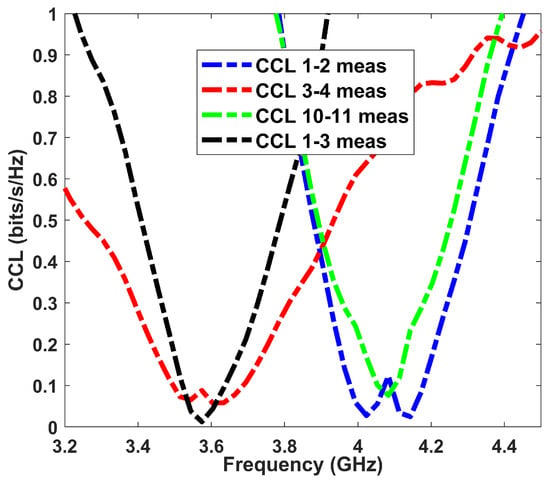
Figure 23.
The measured CCL of the 12-MIMO antenna elements.

Table 3.
Summary of the CCL of the 12-MIMO antenna elements at 3.5 GHz.
The specific absorption rate (SAR) is used to estimate the amount of electromagnetic energy absorbed by the human body, representing the power absorbed per unit mass of body or head tissue, averaged over a 10 g sample. To calculate the absorbed electromagnetic energy, the Katga phantom head model from CST voxel models, based on European standards, has been utilized. The distance was varied between 5 mm and 10 mm to determine the estimated SAR for the MIMO antenna design. Figure 24a–l illustrate the power absorption of the 12-MIMO system by head tissue, averaged over 10 g, in compliance with EU standards. The results indicate that SAR values for all 12-MIMO antenna elements remain below the safety threshold of 2 W/kg. The highest SAR value is at antenna 9 with a value of 1.98 W/kg, as shown in Figure 24i, which is still less than 2 W/kg, while other antenna elements’ SAR is much lower than the safety limit. The simulated SAR values of the 12-MIMO antenna system satisfy the defined EU standard achieving values less than 2 W/kg. As a result, the obtained SAR results confirm that the proposed 12-MIMO antenna design is safe for user interaction and well-suited for implementation in 5G mobile applications.
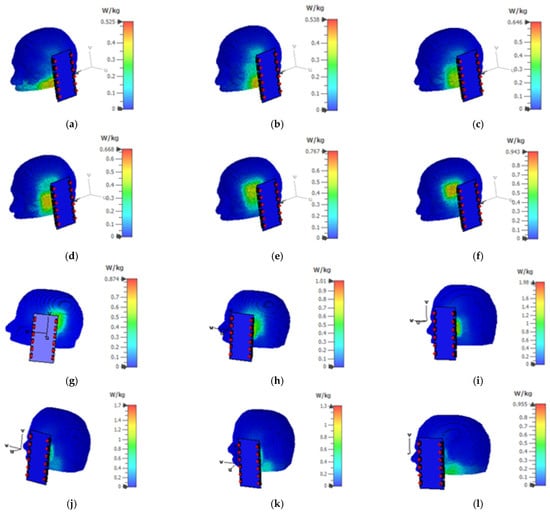
Figure 24.
SAR over 10 g at 3.5 GHz: (a) Ant 1, (b) Ant 2, (c) Ant 3, (d) Ant 4, (e) Ant 5, (f) Ant 6, (g) Ant 7, (h) Ant 8, (i) Ant 9, (j) Ant 10, (k) Ant 11, and (l) Ant 12.
Table 4 presents a comprehensive comparison between the proposed 12-MIMO antenna system, optimized for 5G smartphone applications operated at 3.5 GHz, and relevant recent research studies. This comparison includes several critical parameters, such as the dimensions of an antenna, decoupling level, the number of MIMO antennas, and the spacing between neighboring MIMO antennas. Additionally, it assesses various MIMO performance metrics for the proposed system, including the envelope correlation coefficient (ECC), total active reflection coefficient (TARC), diversity gain (DG), and channel capacity loss (CCL). The findings indicate that the proposed 12-MIMO antenna system features a compact design with minimal required separation distances. Notably, the performance metrics for this system are well below the maximum permissible thresholds: the ECC is less than 0.006, the TARC is below −10 dB, the DG is approximately 10 dB, and the CCL remains under 0.08 bits/s/Hz. Furthermore, the proposed system exhibits significantly enhanced performance metrics compared to previous studies, highlighting notable improvements in MIMO performance and exceptional isolation. Overall, the 12-MIMO antenna system demonstrates substantial advancements in both compactness and isolation, making it highly compatible with 5G smartphone applications.

Table 4.
A comparative analysis of the introduced 12-MIMO antenna elements with relative recent research indicating MIMO performance metrics at the 3.5 GHz spectrum.
6. Conclusions
The 12 × 12 MIMO antenna system, tailored for 5G mobile applications, operates at a frequency of 3.5 GHz. Its design incorporates an inverted U-shaped element, two vertical stubs, two circular rings, a pair of horizontal stubs spanning the rings, and a centrally located T-shaped, coupled-feed element. The separation distance between adjacent antennas in the 12-element MIMO system is only 0.1λ0. Coupling between adjacent MIMO antennas has been significantly minimized through a self-isolating approach, as each antenna functions both as a radiating element and an isolating element. Additionally, the orthogonal mode generated by the double-edge-sided MIMO antennas on the small substrates further enhances the isolation level, ensuring optimal performance in the MIMO configuration.
A prototype of the 12-MIMO antenna system was fabricated for measurement to validate and compare the simulated s-parameters and far-field results. At 3.5 GHz, the lowest measured and simulated transmission coefficient between closely spaced 12-MIMO antenna elements is below −19 dB, highlighting excellent isolation in this compact, high-order MIMO antenna system. To further assess the system’s performance, the envelope correlation coefficient (ECC) was evaluated to verify the mutual coupling effect among the 12-MIMO antenna elements. The highest obtained ECC value was less than 0.06, which is well below the maximum acceptable threshold of 0.5. Additionally, the diversity gain (DG) was computed as another indicator to evaluate the system’s diversity performance. The DG values are approximately 9.99 dB, very close to the ideal value of 10 dB, across all 12-MIMO antenna elements. These results highlight the system’s excellent isolation and diversity performance, making it highly suitable for 5G mobile applications.
Furthermore, the loss of channel capacity due to correlation has been validated using the channel capacity loss (CCL) performance indicator. The highest CCL value observed is less than 0.08 bits/s/Hz, which is significantly lower than the acceptable threshold of 0.4 bits/s/Hz. Additionally, the specific absorption rate (SAR), which measures the amount of electromagnetic field energy absorbed by the human body, has been evaluated for the 12-MIMO antenna system designed for 5G mobile terminals. The obtained SAR values comply with the EU standard, achieving levels of less than 2 W/kg across all antenna elements. These results, encompassing performance metrics of MIMO antennas such as DG, ECC, CCL, and SAR, emphasize the high self-isolation and efficiency of the introduced 12-MIMO antenna system, confirming its suitability for 5G mobile systems. However, for practical implementation of such compact MIMO antennas, the placement of the two small substrates may require a more effective adapter or interface to minimize performance degradation. The accuracy and performance of the practical implementation can be further improved through careful installation and the use of matching adapters.
Author Contributions
Conceptualization, F.G. and J.A.S.; methodology, F.G. and H.A.M.; software, A.S.A.G. and F.A.S.; validation, J.A.S., A.S.A.G. and F.A.S.; formal analysis, F.G., H.A.M. and M.M.B.-S.; writing—original draft preparation, F.G., J.A.S. and H.A.M.; writing—review and editing, A.A.G.A., M.M.B.-S. and H.A.-L. visualization, A.S.A.G. and F.A.S.; supervision, J.A.S. and H.A.M.; project administration, J.A.S. and H.A.M. All authors have read and agreed to the published version of the manuscript.
Funding
This research was backed by Universiti Tun Hussein Onn Malaysia under the TIER 1 research grant (Q436). The authors would also like to acknowledge the support of Sultan Qaboos University, Oman, through the research grant IG/ENG/ECED/22/02.
Data Availability Statement
The data generated during and/or analyzed during the current study are available from the corresponding author upon reasonable request.
Acknowledgments
The authors extend their gratitude to the Faculty of Engineering Technology, for offering the essential research infrastructure and support.
Conflicts of Interest
The authors confirm that there are no conflicts of interest to disclose.
References
- Wang, Y.; Li, J.; Huang, L.; Jing, Y.; Georgakopoulos, A.; Demestichas, P. 5G mobile: Spectrum broadening to higher-frequency bands to support high data rates. IEEE Veh. Technol. Mag. 2014, 9, 39–46. [Google Scholar] [CrossRef]
- Wong, K.; Chen, Y.; Li, W. Decoupled compact ultra-wideband MIMO antennas covering 3300∼6000 MHz for the fifth-generation mobile and 5GHz-WLAN operations in the future smartphone. Microw. Opt. Technol. Lett. 2018, 60, 2345–2351. [Google Scholar] [CrossRef]
- Li, R.; Mo, Z.; Sun, H.; Sun, X.; Du, G. A low-profile and high-isolated MIMO antenna for 5G mobile terminal. Micromachines 2020, 11, 360. [Google Scholar] [CrossRef] [PubMed]
- Ibrahim, S.K.; Singh, M.J.; Al-Bawri, S.S.; Ibrahim, H.H.; Islam, M.T.; Islam, M.S.; Alzamil, A.; Abdulkawi, W.M. Design, Challenges and Developments for 5G Massive MIMO Antenna Systems at Sub 6-GHz Band: A Review. Nanomaterials 2023, 13, 520. [Google Scholar] [CrossRef]
- Hazarika, A.; Rahmati, M. Towards an Evolved Immersive Experience: Exploring 5G- and Beyond-Enabled Ultra-Low-Latency Communications for Augmented and Virtual Reality. Sensors 2023, 23, 3682. [Google Scholar] [CrossRef] [PubMed]
- Ojaroudi Parchin, N.; Jahanbakhsh Basherlou, H.; Al-Yasir, Y.I.A.; Abdulkhaleq, A.M.; Patwary, M.; Abd-Alhameed, R.A. A New CPW-Fed Diversity Antenna for MIMO 5G Smartphones. Electronics 2020, 9, 261. [Google Scholar] [CrossRef]
- Elshirkasi, A.M.; Abdullah Al-Hadi, A.; Khan, R.; Akkaraekthalin, P.; Abdelmula, H.S.B.; Belghasem, A.M.; Jebril, A.H.; Soh, P.J. Numerical Analysis of Users’ Body Effects on a Fourteen-Element Dual-Band 5G MIMO Mobile Terminal Antenna. IEEE Access 2022, 10, 2083–2096. [Google Scholar] [CrossRef]
- Nej, S.; Ghosh, A.; Ahmad, S.; Kumar, J.; Ghaffar, A.; Hussein, M.I. Design and Characterization of 10-Elements MIMO Antenna with Improved Isolation and Radiation Characteristics for mm-Wave 5G Applications. IEEE Access 2022, 10, 125086–125101. [Google Scholar] [CrossRef]
- Gupta, A.; Kansal, A.; Chawla, P. Design of a wearable MIMO antenna deployed with an inverted U-shaped ground stub for diversity performance enhancement. Int. J. Microw. Wirel. Technol. 2021, 13, 76–86. [Google Scholar] [CrossRef]
- Jensen, M.A.; Wallace, J.W. A Review of Antennas and Propagation for MIMO Wireless Communications. IEEE Trans. Antennas Propag. 2004, 52, 2810–2824. [Google Scholar] [CrossRef]
- Kim, S.; Nam, S. A compact and wideband linear array antenna with low mutual coupling. IEEE Trans. Antennas Propag. 2019, 67, 5695–5699. [Google Scholar] [CrossRef]
- Khalid, M.; Iffat Naqvi, S.; Hussain, N.; Rahman, M.; Fawad; Mirjavadi, S.S.; Khan, M.J.; Amin, Y. 4-Port MIMO Antenna with Defected Ground Structure for 5G Millimeter Wave Applications. Electronics 2020, 9, 71. [Google Scholar] [CrossRef]
- Wong, K.L.; Lu, J.Y. 3.6-GHz 10-antenna array for mimo operation in the smartphone. Microw. Opt. Technol. Lett. 2015, 57, 1699–1704. [Google Scholar] [CrossRef]
- Kiani, S.H.; Altaf, A.; Abdullah, M.; Muhammad, F.; Shoaib, N.; Anjum, M.R.; Damaševičius, R.; Blažauskas, T. Eight element side edged framed MIMO antenna array for future 5G smart phones. Micromachines 2020, 11, 956. [Google Scholar] [CrossRef]
- Aljaafreh, S.S.; Altarawneh, B.; Alshamaileh, M.H.; Almajali, E.R.; Hussain, R.; Sharawi, M.S.; Xing, L.; Xu, Q. Ten Antenna Array Using a Small Footprint Capacitive-Coupled-Shorted Loop Antenna for 3.5 GHz 5G Smartphone Applications. IEEE Access 2021, 9, 33796–33810. [Google Scholar] [CrossRef]
- Cheng, Y.; Liu, H.; Sheng, B.Q.; Zhu, L. A compact 4-element MIMO antenna for terminal devices. Microw. Opt. Technol. Lett. 2020, 62, 2930–2937. [Google Scholar] [CrossRef]
- Xu, Z.; Deng, C. High-Isolated MIMO Antenna Design Based on Pattern Diversity for 5G Mobile Terminals. IEEE Antennas Wirel. Propag. Lett. 2020, 19, 467–471. [Google Scholar] [CrossRef]
- Elalaouy, O.; EL Ghzaoui, M.; Foshi, J. A high-isolated wideband two-port MIMO antenna for 5G millimeter-wave applications. Results Eng. 2024, 23, 102466. [Google Scholar] [CrossRef]
- Jiang, W.; Liu, B.; Cui, Y.; Hu, W. High-Isolation Eight-Element MIMO Array for 5G Smartphone Applications. IEEE Access 2019, 7, 34104–34112. [Google Scholar] [CrossRef]
- Li, M.; Jiang, L.; Yeung, K.L. A General and Systematic Method to Design Neutralization Lines for Isolation Enhancement in MIMO Antenna Arrays. IEEE Trans. Veh. Technol. 2020, 69, 6242–6253. [Google Scholar] [CrossRef]
- Saha, P.B.; Ghoshal, D.; Dash, R.K.; Roy, S. Neutralizing line based triple-band MIMO antenna with polarization diversity for WLAN/C/X band usage. Int. J. Electron. 2023, 110, 405–425. [Google Scholar] [CrossRef]
- Sun, Y.; Tian, M.; Cheng, G.S. Characteristic Mode-Based Neutralization Line Design for MIMO Antenna. Int. J. Antennas Propag. 2022, 2022, 9669114. [Google Scholar] [CrossRef]
- Moses, A.T.Z.; Moses, N. Compact self decoupled MIMO antenna pairs covering 3.4–3.6 GHz band for 5G handheld device applications. AEU—Int. J. Electron. Commun. 2021, 141, 153971. [Google Scholar] [CrossRef]
- Wong, K.-L.; Tsai, C.-Y.; Lu, J.-Y. Two Asymmetrically Mirrored Gap-Coupled Loop Antennas as a Compact Building Block for Eight-Antenna MIMO Array in the Future Smartphone. IEEE Trans. Antennas Propag. 2017, 65, 1765–1778. [Google Scholar] [CrossRef]
- Li, M.; Cheung, S. A Novel Calculation-Based Parasitic Decoupling Technique for Increasing Isolation in Multiple-Element MIMO Antenna Arrays. IEEE Trans. Veh. Technol. 2021, 70, 446–458. [Google Scholar] [CrossRef]
- Roy, S.; Chakraborty, U. Mutual Coupling Reduction in a Multi-band MIMO Antenna Using Meta-Inspired Decoupling Network. Wirel. Pers. Commun. 2020, 114, 3231–3246. [Google Scholar] [CrossRef]
- Singh, H.V.; Tripathi, S.; Mohan, A. Closely-coupled MIMO antenna with high wideband isolation using decoupling circuit. AEU—Int. J. Electron. Commun. 2021, 138, 153833. [Google Scholar] [CrossRef]
- Sufian, M.A.; Hussain, N.; Askari, H.; Park, S.G.; Shin, K.S.; Kim, N. Isolation Enhancement of a Metasurface-Based MIMO Antenna Using Slots and Shorting Pins. IEEE Access 2021, 9, 73533–73543. [Google Scholar] [CrossRef]
- Altaf, A.; Iqbal, A.; Smida, A.; Smida, J.; Althuwayb, A.A.; Hassan Kiani, S.; Alibakhshikenari, M.; Falcone, F.; Limiti, E. Isolation Improvement in UWB-MIMO Antenna System Using Slotted Stub. Electronics 2020, 9, 1582. [Google Scholar] [CrossRef]
- Abubakar, H.S.; Zhao, Z.; Wang, B.; Kiani, S.H.; Parchin, N.O.; Hakim, B. Eight-Port Modified E-Slot MIMO Antenna Array with Enhanced Isolation for 5G Mobile Phone. Electronics 2023, 12, 316. [Google Scholar] [CrossRef]
- Yuan, X.-T.; He, W.; Hong, K.-D.; Han, C.-Z.; Chen, Z.; Yuan, T. Ultra-Wideband MIMO Antenna System with High Element-Isolation for 5G Smartphone Application. IEEE Access 2020, 8, 56281–56289. [Google Scholar] [CrossRef]
- Zhang, H.H.; Yu, G.G.; Liu, X.Z.; Cheng, G.S.; Xu, Y.X.; Liu, Y.; Shi, G.M. Low-SAR MIMO Antenna Array Design Using Characteristic Modes for 5G Mobile Phones. IEEE Trans. Antennas Propag. 2022, 70, 3052–3057. [Google Scholar] [CrossRef]
- Armghan, A.; Patel, S.K.; Lavadiya, S.; Qamar, S.; Alsharari, M.; Daher, M.G.; Althuwayb, A.A.; Alenezi, F.; Aliqab, K. Design and Fabrication of Compact, Multiband, High Gain, High Isolation, Metamaterial-Based MIMO Antennas for Wireless Communication Systems. Micromachines 2023, 14, 357. [Google Scholar] [CrossRef] [PubMed]
- Ameen, M.; Chaudhary, R.K. Isolation Enhancement of Metamaterial-Inspired Two-Port MIMO Antenna Using Hybrid Techniques. IEEE Trans. Circuits Syst. II Express Briefs 2023, 70, 1966–1970. [Google Scholar] [CrossRef]
- Puri, V.; Singh, H.S. Design of an isolation improved MIMO antenna using metasurface based absorber for wireless applications. Optik 2022, 259, 168963. [Google Scholar] [CrossRef]
- Sengar, S.; Malik, P.K.; Chandra Srivastava, P.; Srivastava, K.; Gehlot, A. Performance Analysis of MIMO Antenna Design with High Isolation Techniques for 5 G Wireless Systems. Int. J. Antennas Propag. 2023, 2023, 1566430. [Google Scholar] [CrossRef]
- Singh, H.V.; Prasad, D.V.S.; Tripathi, S. Self-isolated MIMO antenna using mixed coupling by close coupling technique. Sci. Rep. 2023, 13, 5636. [Google Scholar] [CrossRef]
- Muhsin, M.Y.; Salim, A.J.; Ali, J.K. A Compact Self-Isolated MIMO Antenna System for 5G Mobile Terminals. Comput. Syst. Sci. Eng. 2022, 42, 919–934. [Google Scholar] [CrossRef]
- Bait-Suwailam, M.M.; Siddiqui, O.F.; Ramahi, O.M. Mutual Coupling Reduction Between Microstrip Patch Antennas Using Slotted-Complementary Split-Ring Resonators. IEEE Antennas Wirel. Propag. Lett. 2010, 9, 876–878. [Google Scholar] [CrossRef]
- Bait-Suwailam, M.M.; Boybay, M.S.; Ramahi, O.M. Electromagnetic Coupling Reduction in High-Profile Monopole Antennas Using Single-Negative Magnetic Metamaterials for MIMO Applications. IEEE Trans. Antennas Propag. 2010, 58, 2894–2902. [Google Scholar] [CrossRef]
- Mengozzi, M.; Gibiino, G.P.; Angelotti, A.M.; Florian, C.; Santarelli, A. Beam-Dependent Active Array Linearization by Global Feature-Based Machine Learning. IEEE Microw. Wirel. Technol. Lett. 2023, 33, 895–898. [Google Scholar] [CrossRef]
- Matta, L.; Sharma, B.; Sharma, M. A review on bandwidth enhancement techniques and band-notched characteristics of MIMO-ultra wide band antennas. Wirel. Netw. 2024, 30, 1339–1382. [Google Scholar] [CrossRef]
- Dhasarathan, V.; Nguyen, T.K.; Sharma, M.; Patel, S.K.; Mittal, S.K.; Pandian, M.T. Design, analysis and characterization of four port multiple-input-multiple-output UWB-X band antenna with band rejection ability for wireless network applications. Wirel. Netw. 2020, 26, 4287–4302. [Google Scholar] [CrossRef]
- Sharma, P.; Tiwari, R.N.; Singh, P.; Kumar, P.; Kanaujia, B.K. MIMO Antennas: Design Approaches, Techniques and Applications. Sensors 2022, 22, 7813. [Google Scholar] [CrossRef] [PubMed]
- Khan, A.; Wakeel, A.; Qu, L.; Zahid, Z. Dual-band 8 × 8 MIMO antenna with enhanced isolation and efficiency for 5G smartphone applications. AEU—Int. J. Electron. Commun. 2023, 163, 154600. [Google Scholar] [CrossRef]
- Yu, H.; Shang, X.; Xue, Q.; Ding, H.; Wang, J.; Lv, W.; Luo, Y. Twelve-Element MIMO Wideband Antenna Array Operating at 3.3 GHz for 5G Smartphone Applications. Electronics 2024, 13, 3585. [Google Scholar] [CrossRef]
- Gautam, A.K.; Yadav, S.; Rambabu, K. Design of ultra-compact UWB antenna with band-notched characteristics for MIMO applications. IET Microw. Antennas Propag. 2018, 12, 1895–1900. [Google Scholar]
- Rubani, Q.; Gupta, S.H.; Rajawat, A. A compact MIMO antenna for WBAN operating at Terahertz frequency. Optik 2020, 207, 164447. [Google Scholar]
- Rekha, V.S.D.; Pardhasaradhi, P.; Madhav, B.T.P.; Devi, Y.U. Dual Band Notched Orthogonal 4-Element MIMO Antenna with Isolation for UWB Applications. IEEE Access 2020, 8, 145871–145880. [Google Scholar]
- Chen, Z.; Liu, Y.; Yuan, T.; Wong, H. A Miniaturized MIMO Antenna with Dual-Band for 5G Smartphone Application. IEEE Open J. Antennas Propag. 2023, 4, 111–117. [Google Scholar]
- Ghawbar, F.; Sukor, J.A.; Majid, H.A.; Ghafar, A.S.A.; Saparudin, F.A.; Esmail, B.A.F.; Almohammedi, A.A.; Esmail, A.G. High Isolated 10-MIMO Antenna Elements for 5G Mobile Applications. Int. J. Integr. Eng. 2023, 15, 265–276. [Google Scholar]
Disclaimer/Publisher’s Note: The statements, opinions and data contained in all publications are solely those of the individual author(s) and contributor(s) and not of MDPI and/or the editor(s). MDPI and/or the editor(s) disclaim responsibility for any injury to people or property resulting from any ideas, methods, instructions or products referred to in the content. |
© 2025 by the authors. Licensee MDPI, Basel, Switzerland. This article is an open access article distributed under the terms and conditions of the Creative Commons Attribution (CC BY) license (https://creativecommons.org/licenses/by/4.0/).